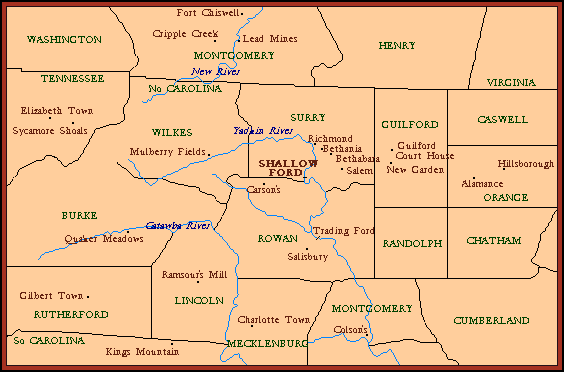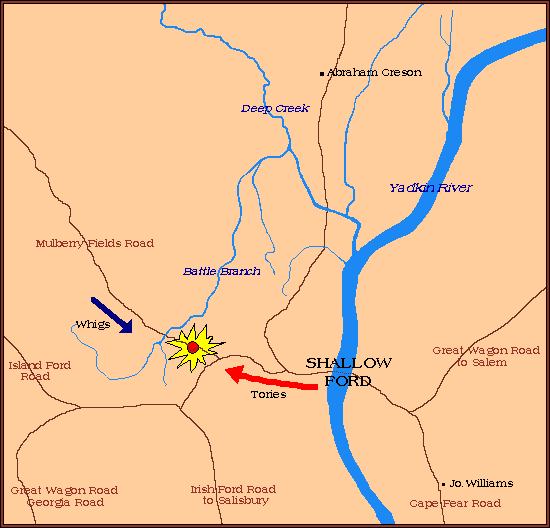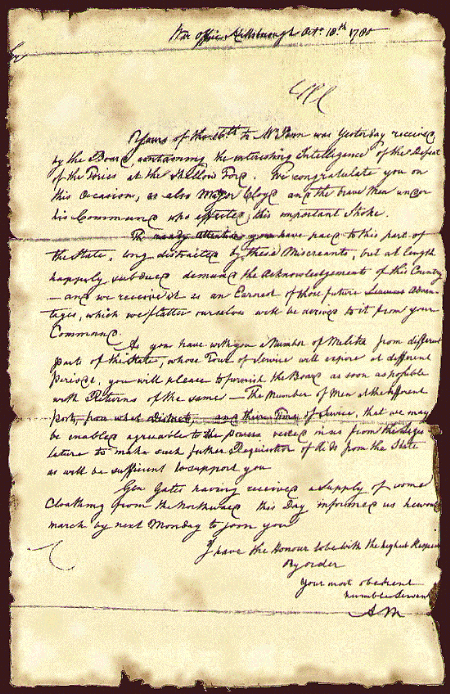 In the days of early fall, 1780, the Patriot forces in North Carolina were demoralized by heavy losses in South Carolina and British General Lord Cornwallis' advancement to Charlotte. Many fled to Virginia ahead of the British. Patrick Ferguson, one of Cornwallis' Colonels, had moved into western North Carolina, raising Tory support for his army.
In the days of early fall, 1780, the Patriot forces in North Carolina were demoralized by heavy losses in South Carolina and British General Lord Cornwallis' advancement to Charlotte. Many fled to Virginia ahead of the British. Patrick Ferguson, one of Cornwallis' Colonels, had moved into western North Carolina, raising Tory support for his army.
The Patriot forces prepared to meet Col. Ferguson. Most of the Surry County militia, along with other North Carolinians, rendezvoused at Quaker Meadows (near Morganton) on September 30th. They were joined by "over the mountain men" from Virginia and Tennessee. They expected to find Ferguson near Gilbert Town (Rutherfordton), but did not catch him until they reached Kings Mountain on October 7th.
In Surry County, in the absence of the local Whig militia, the brothers and Colonels Gideon and Hezekiah Wright raised a large band of Tories which finally may have reached a number as high as 900. On October 3rd and 8th, they attacked Whig targets in the town of Richmond, the County seat, where they killed the Sheriff of the County. Patriot intelligence believed that the local Tories intended to join Lord Cornwallis' forces in Charlotte. Patriot General William Lee Davidson, near Charlotte, sent out a company of 52 under Andrew Carson to meet the Tory forces in Surry County. General Jethro Sumner, near Salisbury, dispatched two companies of 30 men each under Captain Jacob Nichols and Captain _____ Miller. Those Whigs who remained in Surry County gathered and joined the arriving Patriot forces.
Four companies of Patriots, numbering about 160, from Montgomery County, Virginia, under Maj. Joseph Cloyd and Captains Henry Francis, Isaac Campbell, George Parris, and Abraham Trigg had followed earlier troops headed to meet Col. Ferguson. When they reached western North Carolina, they learned of Ferguson's defeat at Kings Mountain, and were redirected to Surry County. These four companies from Virginia (about 160 men) joined with the first three companies sent out from Charlotte and Salisbury (about 110 men) and with the local Surry county militiamen who had not pursued Ferguson (about 80 men). On Saturday morning, October 14th, about 9:30 a.m., this force of 350 men were on the west side of a small stream, now called the Battle Branch, near the Shallow Ford crossing of the Yadkin River.
 Suddenly they saw the head of the Tory force which had threatened the county for the past weeks. Numbering between 400 and 900, they had crossed the Yadkin and were moving westward on the Mulberry Fields Road. Both sides hastily formed and fired several rounds at each other. The Whigs, though outnumbered, quickly gained the advantage. Captain (James?) Bryan, of the notorious Tory Bryan clan, who led the Tory forces, was quickly killed, along with 13 others. The Tories retreated pell-mell back across the Yadkin, shouting "we are whipped, we are whipped." As they were well mounted, they made good their escape. Captain Henry Francis of the Whigs lost his life, and four others were wounded. The battle probably lasted about 45 minutes.
Suddenly they saw the head of the Tory force which had threatened the county for the past weeks. Numbering between 400 and 900, they had crossed the Yadkin and were moving westward on the Mulberry Fields Road. Both sides hastily formed and fired several rounds at each other. The Whigs, though outnumbered, quickly gained the advantage. Captain (James?) Bryan, of the notorious Tory Bryan clan, who led the Tory forces, was quickly killed, along with 13 others. The Tories retreated pell-mell back across the Yadkin, shouting "we are whipped, we are whipped." As they were well mounted, they made good their escape. Captain Henry Francis of the Whigs lost his life, and four others were wounded. The battle probably lasted about 45 minutes.
When reports of the Tories had worsened, General Sumner (near Salisbury) had dispatched an additional 300 militiamen under Col. John Peasley. They arrived at the close of the battle, as did Col. Joseph Williams of Surry County, who had heard the rifle fire from his nearby home. Captain Francis was buried on the battlefield. The dead Tories were buried in a separate common grave. The 4 wounded Whigs and 1 wounded Tory were cared for by a Moravian physician and his assistant, first in the area of the battle, and then in Bethania, where they were taken to recover from their wounds. Over the next several days the Patriots went to the Moravian towns (Winston-Salem), cold and wet from rains that began late on the 14th. General William Smallwood with his troops, also in search of the Tories, arrived in the Moravian towns and was elated to learn of the Patriots' victory. Within several days, most of them left for home.
 On October 19th, the Field Officers of the Patriots held a Council on nearby land owned by Abraham Creson. The Council directed that all those who had supported the Tory cause be offered a pardon, upon meeting specified conditions. Many availed themselves of this offer.
On October 19th, the Field Officers of the Patriots held a Council on nearby land owned by Abraham Creson. The Council directed that all those who had supported the Tory cause be offered a pardon, upon meeting specified conditions. Many availed themselves of this offer.
News of the victory at Shallow Ford spread quickly, and greatly encouraged the Patriots. After the defeat at Kings Mountain, Lord Cornwallis retreated from Charlotte. The victory at Shallow Ford dispersed the Tory force that had formed in Surry County, and they never again gathered in such numbers.
The Battle of Shallow Ford has long been overlooked by historians. Recent research shows that, at the time, it was a significant victory for the Patriot forces. Occurring exactly a week after Kings Mountain, these two battles turned the tide of the War for Independence in North Carolina to the Patriots' advantage.

A more detailed account of the battle has been published online in the Early America Review: Magdalena's Story, The Battle of Shallow Ford as Told by the Wife of a Militia Man
© 1994-2011 Ann Brownlee. This page was created on December 1, 1996 by Ann Brownlee. Last revision August 2011.